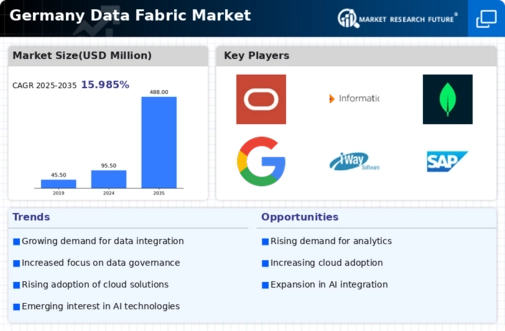Expansion of IoT and Edge Computing
The expansion of the Internet of Things (IoT) and edge computing is significantly influencing the data fabric market in Germany. As more devices become interconnected, the volume of data generated at the edge is increasing exponentially. This trend necessitates the development of data fabric solutions that can efficiently manage and process data from edge devices. The data fabric market is likely to see substantial growth as organizations seek to harness the potential of IoT and edge computing for real-time analytics and decision-making. Projections suggest that the market for edge computing solutions will grow by approximately 20% annually over the next few years, further driving the demand for data fabric technologies that can support this evolving landscape.
Increased Focus on Data Integration
The data fabric market in Germany is witnessing an increased focus on data integration as organizations strive to unify disparate data sources. As businesses accumulate data from various channels, the need for cohesive data management solutions becomes paramount. This trend is particularly relevant industries such as healthcare and manufacturing, where data silos can hinder operational efficiency. The data fabric market is responding to this challenge by offering solutions that facilitate seamless data integration across platforms. Recent studies indicate that organizations that prioritize data integration can achieve up to 40% improvements in operational efficiency. Consequently, the demand for data fabric technologies that enable comprehensive data integration is expected to rise significantly.
Emphasis on Data Security and Compliance
In the context of the data fabric market, the emphasis on data security and compliance is becoming increasingly pronounced in Germany. With stringent regulations such as the General Data Protection Regulation (GDPR) in place, organizations are compelled to adopt robust data management practices. This regulatory landscape necessitates the implementation of data fabric solutions that ensure data integrity and security while facilitating compliance. As a result, companies are investing in technologies that provide end-to-end encryption, access controls, and audit trails. The data fabric market is likely to see a significant uptick in demand for solutions that address these security concerns, as businesses strive to protect sensitive information and avoid potential penalties associated with non-compliance.
Rising Demand for Real-Time Data Processing
The data fabric market in Germany experiences a notable surge in demand for real-time data processing capabilities. Organizations are increasingly recognizing the necessity of accessing and analyzing data instantaneously to make informed decisions. This trend is particularly evident in sectors such as finance and retail, where timely insights can lead to competitive advantages. According to recent estimates, the market for real-time data processing solutions is projected to grow at a CAGR of approximately 25% over the next five years. This growth is likely to drive investments in data fabric technologies, as companies seek to enhance their operational efficiency and responsiveness. Consequently, the data fabric market is poised to benefit from this rising demand, as businesses prioritize solutions that facilitate real-time data integration and analytics.
Growth of Artificial Intelligence and Machine Learning
The integration of artificial intelligence (AI) and machine learning (ML) technologies is driving transformation within the data fabric market in Germany. Organizations are increasingly leveraging AI and ML to enhance data analytics capabilities, automate processes, and derive actionable insights from vast datasets. This trend is reflected in the growing investment in AI-driven data fabric solutions, which are expected to witness a CAGR of around 30% in the coming years. The data fabric market stands to gain from this growth, as businesses seek to harness the power of AI and ML to improve decision-making and operational efficiency. Furthermore, the ability to seamlessly integrate AI and ML into existing data architectures is likely to be a key differentiator for organizations aiming to remain competitive.
















